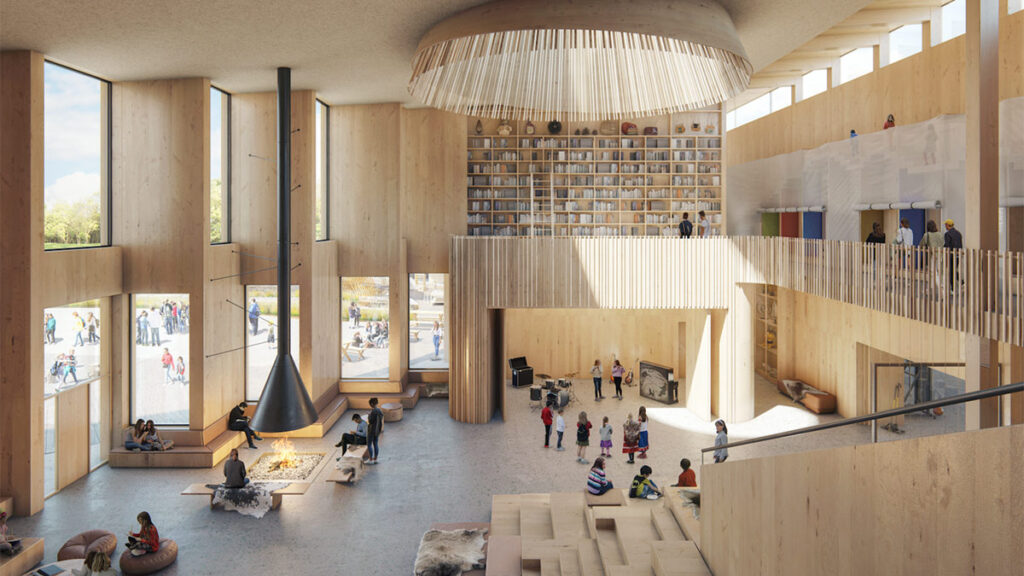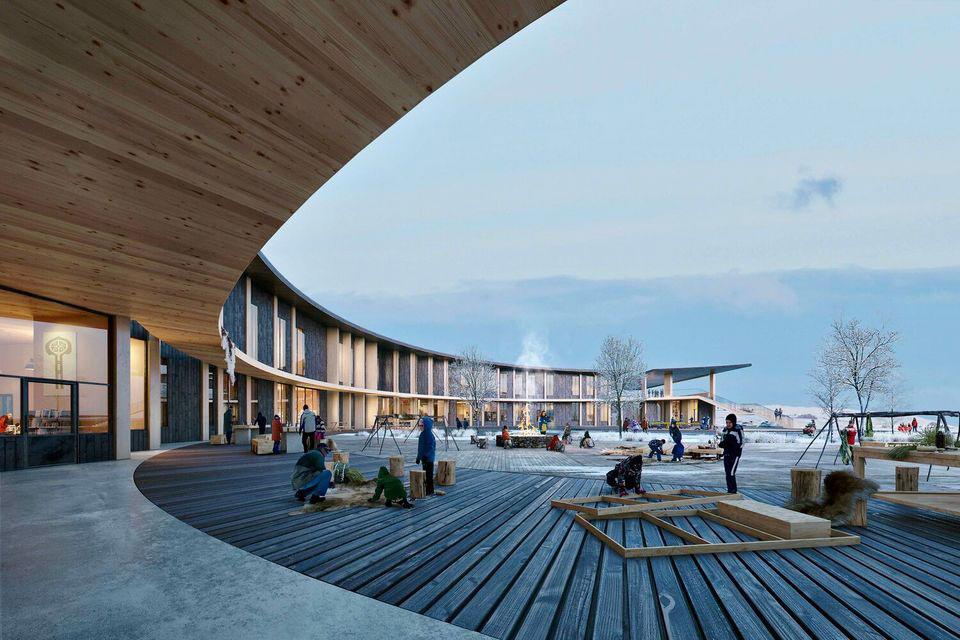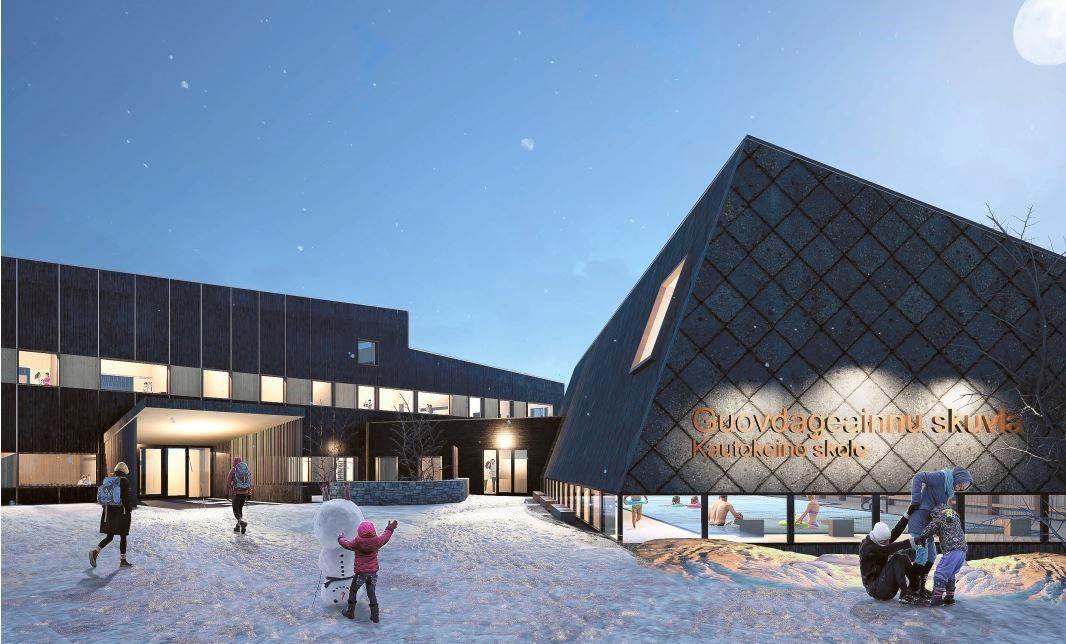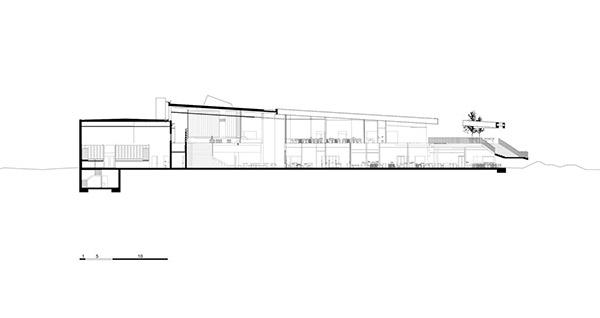A school with the hygge factor
Kautokeino skole in northern Norway is a project that seeks to embrace the uniqueness of Sami culture and educational style. The mass wood building is so hygge, you’ll want to check in for a few nights.
Huge quantities of light-coloured wood make the large hall look extremely inviting and cosy. Around an open fireplace, children sit on benches draped with reindeer skins. High up in the ceiling, a round skylight is remeasurement of the opening in the Kote or Gamme, the traditional dwellings of the Sami people. The visualizations of the new Sami school – Kautokeino – present an auditorium that could just as easily pass for the lobby of a modern eco resort. Norwegian architecture firm Ola Roald Arkitektur shows how architecture can help to shape cultural identity. And that a school can be just as hygge as a hotel.
The rediscovery of ancient knowledge
“Guovdageainnu skuvla” is written in large letters at the entrance to the annex of the new school, which houses the swimming pool. Below the Sami name, in smaller letters, is the name of the school in Norwegian: Kautokeino skole. It wasn’t always like that. The Sami, like countless other indigenous peoples, were colonized and Christianized over centuries. Efforts to undo the mistakes of colonial oppression are visible in many places. In northern Norway, today the Sami people have their own university and their own schools where Sami languages are taught. They even have their own parliament.
In the fight against climate change, the knowledge of indigenous peoples is increasingly coming to the fore. After all, living in harmony with nature has always been part of their cultural self-image. The cradle-to-cradle principle is now considered a modern stroke of genius on the road to climate protection. Yet it is a concept that indigenous people like the Sami have always lived by. Their Kote (tents) and Gamme (mud huts) are made of zero-kilometre building materials, and the green walls act as climate control. Everything described as progress in climate technology today is essentially the ancient knowledge of indigenous peoples who were previously branded as regressive.
Ecological showcase project
The new primary and secondary school in the municipality of Kautokeino is a showcase project for ecological building. And it is therefore entirely in keeping with Sami culture. While the people are a minority in Norway today, the Sami make up the majority of the population in Kautokeino. They still live mainly from traditional reindeer farming. Their interesting culture and the awe-inspiring northern lights are drawing more and more tourists to the region.
Everything concrete can do, wood can do just as well, and with a far better eco footprint.
Milica Nikolic, ACE Arheget
Apart from the indoor swimming pool and the supporting walls, the new school will be built entirely in mass timber. The engineers from Acetra have estimated that 2,100 cubic metres of wood will be required for the total area of 5,000 square metres. The timber construction specialist based in Belgrade is responsible for the technical construction and calculates the construction and strength of cross-laminated timber (CLT) and glued laminated timber (GL).
“Everything concrete can do, wood can do just as well, and with a far better eco footprint,” says Milica Nikolic from Acetra, explaining the advantages of modern timber construction. A look at the company’s portfolio with its numerous major international projects shows that timber construction is slowly but surely emerging from its niche. Now is the time to act, the head of Business Development is convinced. “Timber construction alone cannot stop climate change, but if we join forces across all industries, we can do it.”
Sami educational style
The Kautokeino school has not only its own teaching language, but also its own educational style. The experience-based learning of the Sami is fundamentally different from the text-based schooling of Western culture and is taught at university level today. This special way of teaching also influenced the architectural concept.
A creative, intuitive and practical approach to things is anchored in the Sami culture, and this is reflected in the design.
Einar Bjarki Malmquist, Ola Roald Arkitekter
“The project is very challenging, in a good way,” explains architect Einar Bjarki Malmquist from Oslo-based Ola Roald. Its cultural and functional approach is different from the other school projects the firm designs and builds. “A creative, intuitive and practical approach to things is anchored in the Sami culture, and this is reflected in the design.”
A circular outdoor space connects the different areas inside and outside the school. From here, there is direct access to the school auditorium and the workrooms. To further underscore the Sami culture, a dedicated nature school has been integrated into the educational institution. As well as creating a positive indoor climate, the use of wood as a building material is also in keeping with Sami culture because, as Malmquist says: “Wood offers almost endless possibilities for a creative mindset.”
Text: Gertraud Gerst
Visualizations: Ola Roald Arkitekter



